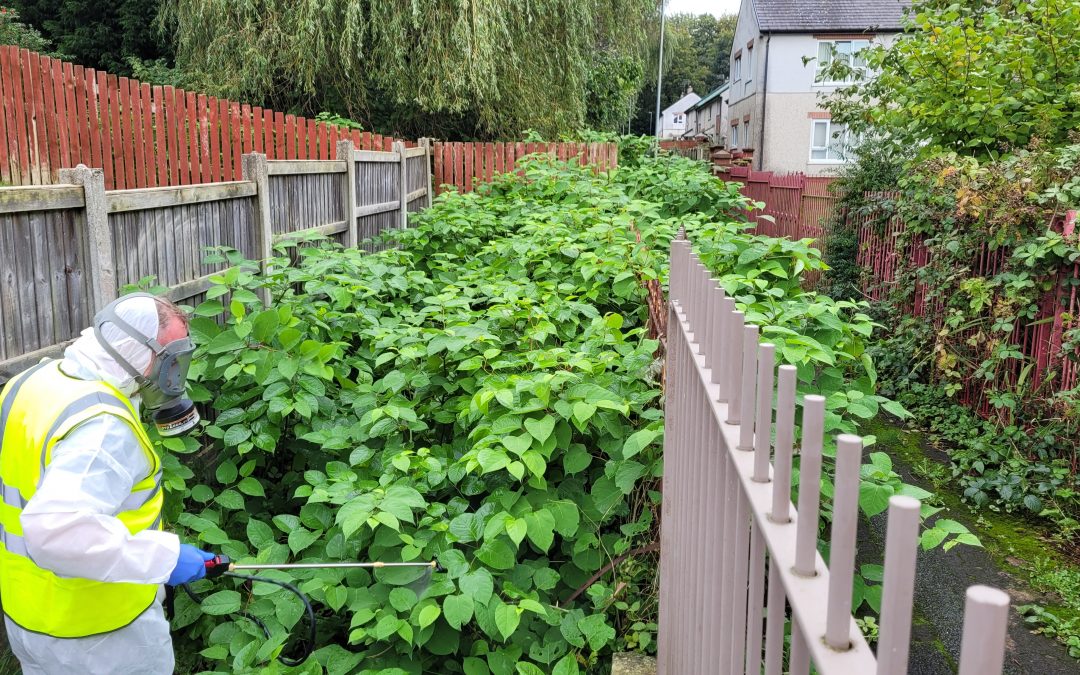What time of year do you treat knotweed?
The timing for treating Japanese knotweed
Depends on the control method used and the growth cycle of the plant. Different treatments are applied at specific times of the year to maximise their effectiveness. Here’s a general overview of when Japanese knotweed is treated based on the control methods:
Herbicide Treatment:
Herbicide treatments are commonly used to control Japanese knotweed. The best time to apply herbicides is late summer or early autumn, typically from August to September. During this period, the plant transports nutrients from the leaves to the rhizomes in preparation for winter dormancy. Applying herbicides at this time ensures that the chemicals are efficiently translocated to the rhizomes, weakening the plant and inhibiting its growth in the following seasons.
Excavation and Removal:
For excavation and removal methods, treatment can be carried out during the active growth period of Japanese knotweed, typically from late spring to early autumn (May to September). During this time, the plant is above ground and easily identifiable. Excavation involves removing the plant and its rhizomes from the soil, and this process can be carried out during the active growing season when the plant is most visible.
Burial:
Burial is another control method that can be performed during the active growing season (late spring to early autumn). Like excavation and removal, the plant is visible and can be dug out and buried at considerable depths to prevent regrowth.
Remembering treatment timing may vary depending on regional climate conditions and the specific growth patterns of Japanese knotweed in your area is essential. Professional specialists or Japanese knotweed removal companies can provide detailed advice on the best treatment timing based on local factors.
Additionally,
early detection and treatment are critical to effectively managing Japanese knotweed. The smaller the infestation and the earlier the treatment, the more successful the control efforts will likely be. Regular monitoring of the site and prompt action upon detecting Japanese knotweed can help prevent its further spread and reduce the extent of the infestation.
Overall, treating Japanese knotweed at the appropriate time of year using the proper control method and adhering to a comprehensive management plan are essential steps in effectively managing and eradicating this invasive plant.
What time of year do you treat knotweed? Treating Japanese knotweed in June and September in the UK is often considered optimal for several reasons:
Growth Patterns:
Japanese knotweed rapidly grows in June, putting a lot of energy into producing foliage and stems. This means systemic herbicides, absorbed through the leaves and transported throughout the plant to the roots, are more effective as the plant is actively growing. Its transport systems are working at full capacity.
Herbicide Absorption:
The large leaf area in June allows maximum herbicide absorption, leading to a more effective treatment.
Energy Reserves:
By September, the plant begins to prepare for winter, drawing nutrients back into the rhizomes to store energy. Applying herbicides at this time can be particularly effective because the plant is naturally moving materials to the roots, aiding in the delivery of the herbicide to the area of the plant that is most difficult to kill.
Weather Conditions:
The UK’s climate in June and September is generally mild and stable, favouring herbicide application. Herbicides require a specific temperature range to be most effective, and rain shortly after application can wash the chemicals away before the plant can absorb them. The weather during these months is less likely to interfere with treatment.
Lifecycle Disruption:
Treating in these months aligns well with disrupting the plant’s lifecycle. In June, before it can flower and potentially spread through seeding (although this is rare in the UK), and again in September, before it withdraws to its rhizomes for the winter, can double the impact of the treatment efforts.
So when I’m asked what time of year you treat knotweed,
It’s important to note that while June and September are generally the best times to treat Japanese knotweed, the specific timing can vary depending on the weather patterns in a given year and the particular conditions of the infestation site. You should always consult a professional who can provide tailored advice based on the local environment.
